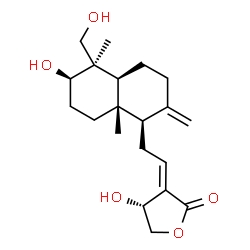14-Deoxy-11,12-didehydroandrographolide

14-Deoxy-11,12-didehydroandrographolide structure
|
Common Name | 14-Deoxy-11,12-didehydroandrographolide | ||
|---|---|---|---|---|
| CAS Number | 42895-58-9 | Molecular Weight | 332.434 | |
| Density | 1.2±0.1 g/cm3 | Boiling Point | 519.6±50.0 °C at 760 mmHg | |
| Molecular Formula | C20H28O4 | Melting Point | 204-205ºC | |
| MSDS | Chinese USA | Flash Point | 182.4±23.6 °C | |
Use of 14-Deoxy-11,12-didehydroandrographolide14-Deoxy-11,12-didehydroandrographolide is an analogue of Andrographolide that can be isolated from A. paniculata. 14-Deoxy-11,12-didehydroandrographolide inhibits NF-κB activation. |
| Name | 14-Deoxy-11,12-didehydroandrographolide |
|---|---|
| Synonym | More Synonyms |
| Description | 14-Deoxy-11,12-didehydroandrographolide is an analogue of Andrographolide that can be isolated from A. paniculata. 14-Deoxy-11,12-didehydroandrographolide inhibits NF-κB activation. |
|---|---|
| Related Catalog | |
| Target |
NF-κB |
| In Vitro | 14-deoxy-11,12-didehydroandrographolide, a naturally occurring noncytotoxic analogue of Andrographolide, effectively reduces Ovalbumin (OVA)-induced inflammatory cell recruitment into bronchoalveolar lavage (BAL) fluid, IL-4, IL-5, IL-13, and eotaxin production, serum IgE synthesis, pulmonary eosinophilia, mucus hypersecretion, mast cell degranulation, and airway hyper-responsiveness (AHR) in a mouse asthma model, probably via inhibition of NF-κB activity[1]. |
| In Vivo | 14-deoxy-11,12-didehydroandrographolide (1 mg/kg) dramatically reduces resistance (Rl) and restores Cdyn in OVA-challenged mice in response to methacholine[1]. |
| Cell Assay | A549 cells (3×103/well), BEAS-2B cells (5×103/well), and RBL-2H3 cells (3×103/well) are seeded in flat-bottomed 96-well plates overnight and then incubated with increasing concentrations (3-120 μM) of 14-deoxy-11,12-didehydroandrographolide or Andrographolide for 24 and 48 h at 37°C. Cell viability is analyzed using the CellTiter 96 AQueous cell proliferation assay. This MTS assay is based on the ability of viable cells to convert a soluble tetrazolium salt to a colored formazan product. Absorbance is recorded at 490 nm[1]. |
| Animal Admin | Mice[1] Female BALB/c mice, 6 to 8 weeks old, are sensitized and challenged with OVA. Briefly, mice are sensitized by ip injections of 20 μg of OVA and 4 mg of Al(OH)3 suspended in 0.1 mL of saline on days 0 and 14. On days 22, 23, and 24, mice are challenged with 1% OVA aerosol for 30 min. 14-deoxy-11,12-didehydroandrographolide (0.1, 0.5, and 1 mg/kg) or vehicle (1% DMSO) in 0.1 mL of saline is given by ip injections 2 h before and 10 h after each OVA aerosol challenge. Saline aerosol is used as a negative control. |
| References |
| Density | 1.2±0.1 g/cm3 |
|---|---|
| Boiling Point | 519.6±50.0 °C at 760 mmHg |
| Melting Point | 204-205ºC |
| Molecular Formula | C20H28O4 |
| Molecular Weight | 332.434 |
| Flash Point | 182.4±23.6 °C |
| Exact Mass | 332.198761 |
| PSA | 66.76000 |
| LogP | 1.89 |
| Vapour Pressure | 0.0±3.1 mmHg at 25°C |
| Index of Refraction | 1.567 |
| Storage condition | -20°C |
| RIDADR | NONH for all modes of transport |
|---|
|
~91% 
14-Deoxy-11,12-... CAS#:42895-58-9 |
| Literature: Xu, Hai-Wei; Zhang, Jianye; Liu, Hong-Min; Wang, Jun-Feng Synthetic Communications, 2006 , vol. 36, # 4 p. 407 - 414 |
|
~% 
14-Deoxy-11,12-... CAS#:42895-58-9 |
| Literature: Matsuda; Kuroyanagi; Sugiyama; Umehara; Ueno; Nishi Chemical and Pharmaceutical Bulletin, 1994 , vol. 42, # 6 p. 1216 - 1225 |
| Precursor 1 | |
|---|---|
| DownStream 0 | |
| 2(5H)-Furanone, 3-[(E)-2-[(1R,4aS,5R,6R,8aR)-decahydro-6-hydroxy-5-(hydroxymethyl)-5,8a-dimethyl-2-methylene-1-naphthalenyl]ethenyl]- |
| 4-[2-[(1R,4aS,5R,6R,8aS)-6-hydroxy-5-(hydroxymethyl)-5,8a-dimethyl-2-methylidene-3,4,4a,6,7,8-hexahydro-1H-naphthalen-1-yl]ethyl]-2H-furan-5-one |
| 3-{(E)-2-[(1R,4aS,5R,6R,8aR)-6-Hydroxy-5-(hydroxymethyl)-5,8a-dimethyl-2-methylenedecahydronaphthalen-1-yl]vinyl}furan-2(5H)-one |
| 3-{(E)-2-[(1R,4aS,5R,6R,8aR)-6-Hydroxy-5-(hydroxymethyl)-5,8a-dimethyl-2-methylenedecahydro-1-naphthalenyl]vinyl}-2(5H)-furanone |




